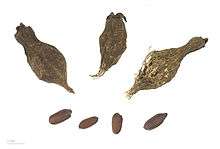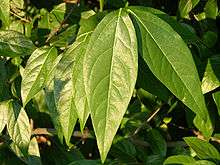Chimonanthus
| Chimonanthus | |
|---|---|
 | |
| Chimonanthus praecox flower | |
| Scientific classification | |
| Kingdom: | Plantae |
| (unranked): | Angiosperms |
| (unranked): | Magnoliids |
| Order: | Laurales |
| Family: | Calycanthaceae |
| Genus: | Chimonanthus Lindl. (1819) |
| Type species | |
| Chimonanthus praecox | |
| Species | |
|
Chimonanthus nitens Oliv. | |
| Synonyms | |
|
Meratia Loiseleur-Deslongchamps | |

Chimonanthus (wintersweet) is a genus of flowering plants in the family Calycanthaceae, endemic to China. It is also grown in Iran, called "ice flower" and probably imported from China. The genus includes three to six species depending on taxonomic interpretation; three are accepted by the Draft Flora of China. The name means winter flower in Greek.
Description
They are deciduous or evergreen shrubs growing to 2–13 m tall. The leaves are opposite, entire, 7–20 cm long and 3–7 cm broad. The flowers are 2–3 cm wide, with numerous spirally-arranged yellow or white tepals; they are strongly scented, and produced in late winter or early spring before the new leaves. The fruit is an elliptic dry capsule 3–4 cm long.
Species
- Chimonanthus caespitosus T.B. Chao
- Chimonanthus campanulatus R.H. Chang & C.S. Ding
- Chimonanthus grammatus M.C. Liu
- Chimonanthus nitens Oliv.
- Chimonanthus campanulatus R.H. Chang & C.S. Ding
- Chimonanthus zhejiangensis M.C. Liu
- Chimonanthus praecox (L.) Link
- Chimonanthus fragrans Lindl.
- Chimonanthus parviflorus Raf.
- Chimonanthus yunnanensis W.W. Sm.
- Chimonanthus salicifolius S.Y. Hu
Source: MBG[4]
Cultivation and uses

Chimonanthus praecox, "wintersweet", is the only species widely grown as an ornamental plant, for its spicily scented winter flowers;[5] these are also used in floristry as cut flowering branches, which can also be forced as with forsythia. The petals are quite waxy. The plant prefers medium exposure to sunlight or high dappled shade,[6] a fresh climate (hardy to USDA Zone 7), and soft, acidic permeable ground not waterlogged in winter.[7] A protected, south-facing wall encourages early flowering, and a position should be chosen where its spicy perfume can be appreciated while coming and going from the house. Space needs to be allowed for its eventual spread to 3 m (10 ft), since untimely summer pruning to keep an ill-sited shrub in check will sacrifice flowering the following winter.
In China Chimonanthus was domesticated during the Song Dynasty and inspired courtly poems from the eleventh century; it flowers at the Chinese New Year, when flowering sprigs are used as hair ornaments. In China, prunings are dried and kept to perfume linen cupboards.[8] The shrub was introduced to Japanese gardens from China in the early Edo period (probably between 1611 and 1629, according to Garden Plants of Japan[9]). Its introduction into European gardens, from Japan, is noted for England, 1766,[10] when it was grown under glass for the sixth Earl of Coventry in the conservatory at Croome Court, Worcestershire. By 1799 that shrub had grown to be 16 feet high and 10 feet wide. By that time it had been tried out of doors without winter protection and proved hardy in the south of England. Slips of it were distributed among nurserymen and so it entered European horticulture.[11] A larger-flowered (though less fragant) variety, "grandiflorus" was grown by the comtesse de Vandes in Bayswater, London, before 1819.[11] A yellow-flowered variety (luteus, 1814[12]) is also noted.
No notice has yet been found of Chimonanthus in an American colonial garden;[13] it was first offered in an American catalogue in 1811.[14] It is hardy at least to New York City,[15] where frosts interrupt, but do not stop the flowering.
The flowers are said to be edible.,[16] and can be used to flavor tea.
At the end of its flowering, since it flowers most freely on ripened young wood and has little summer and autumn interest, it is thinned and pruned similarly to Forsythia by partly heading back and a few thick old stems removed at the ground.
Chimonanthus plants are frequently subject to attacks from aphids, and may be attacked by mites and leaf beetles.
Culture Symbolism
Pine, Bamboo and Chimonanthus are highly appreciated in Chinese culture for their endurance in severe winters. They are referred as Three Friends of Winter or Sui Han San You.
References
- ↑ "Chimonanthus". Index Nominum Genericorum. International Association for Plant Taxonomy. Retrieved 2008-06-02.
- ↑ International Organization for Plant Information (IOPI). "Plant Name Search Results" (HTML). International Plant Names Index. Retrieved 2008-06-02.
- ↑ "Chinese Plant Names". Retrieved 2008-06-02.
- ↑ "Chimonanthus Lindl.". Tropicos. Missouri Botanical Garden. Retrieved 2008-06-02.
- ↑ The large C. nitens is barely scented, and the late summer flowering of C. salicifolius is largely hidden by its leaves; they are grown as botanical curiosities.
- ↑ Sunlight is required to ripen the wood for profuse flowering.
- ↑ Problems stemming from waterlogged winter soils are noted by Michael W. Buffin, Winter-flowering Shrubs (Portland: Timber Press) 2005, p. 106.
- ↑ Alice M. Coats, Flowering Shrubs and Their Histories (1964) 1992, s.v. "Chimonanthus".
- ↑ Ran Levy-Yamamori and Gerard Taaffe, Garden Plants of Japan (Portland: Timber Press) 2004, p. 76f.
- ↑ Robert Sweet, Sweet's Hortus Britannicus (London: Ridgeway), 1827, p. 132, notes the 1766 introduction as Chimonanthus fragrans from Japan, in Botanical Magazine 1766, p. 466.
- 1 2 Coats (1964) 1992.
- ↑ The all-yellow large-flowered variety luteus in modern nursery catalogues is probably a later introduction, from Vilmorin, 1906, according to Alice Coats (1964) 1992.
- ↑ It is not listed in Ann Leighton, American Gardens in the Eighteenth Century: 'For Use and Delight' 1976.
- ↑ James R. Cothran, Gardens and Historic Plants of the Antebellum South (University of South Carolina Press), 2003, p. 266
- ↑ Large shrubs of Chimonanthus praecox may be found in an exposed location by the Belvedere Castle.
- ↑ http://www.pfaf.org/user/Plant.aspx?LatinName=Chimonanthus+praecox
External links
![]() Media related to Chimonanthus at Wikimedia Commons
Media related to Chimonanthus at Wikimedia Commons
![]() Data related to Chimonanthus at Wikispecies
Data related to Chimonanthus at Wikispecies